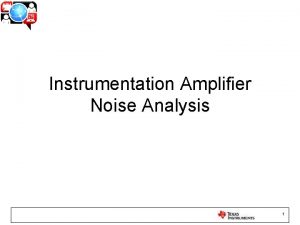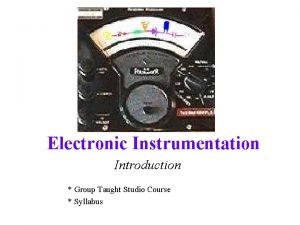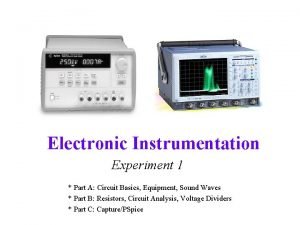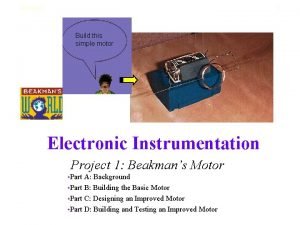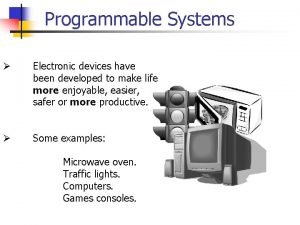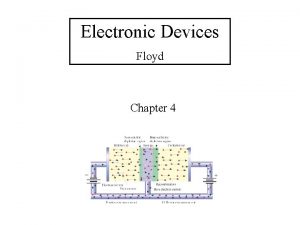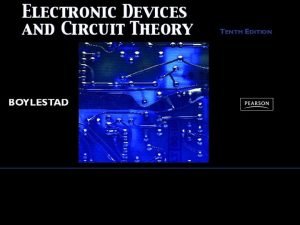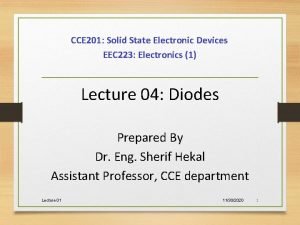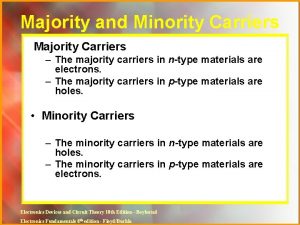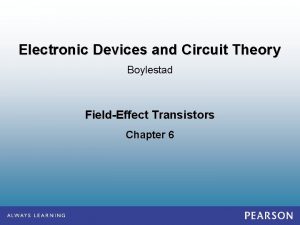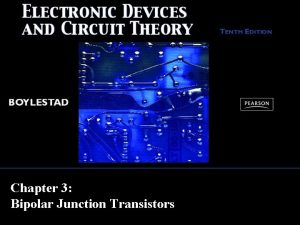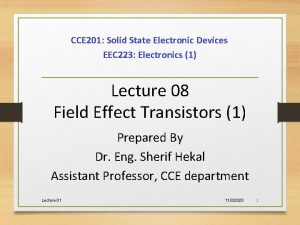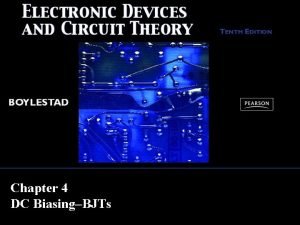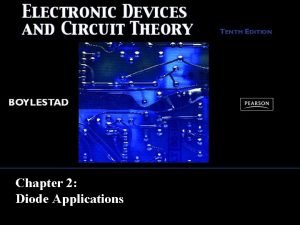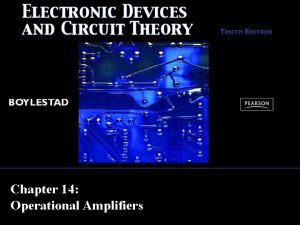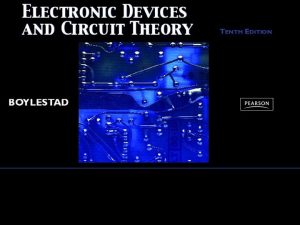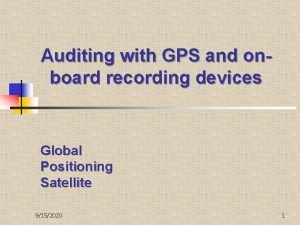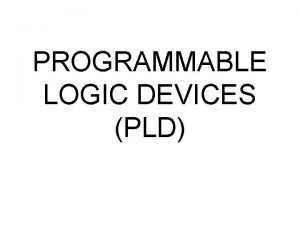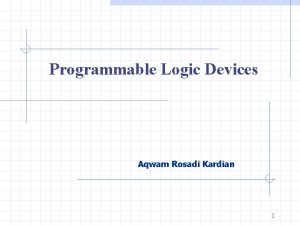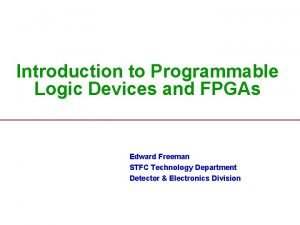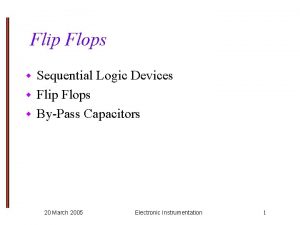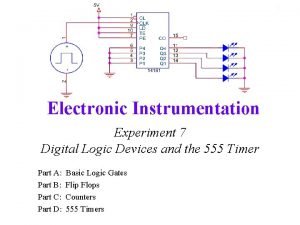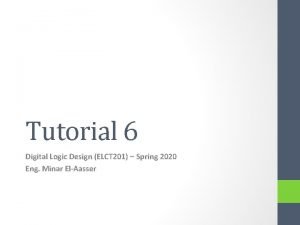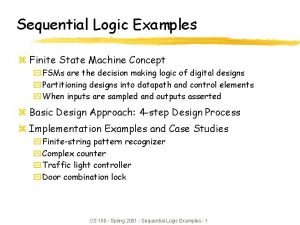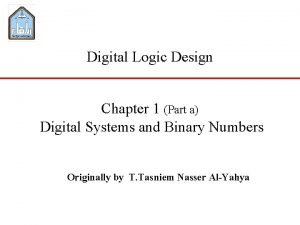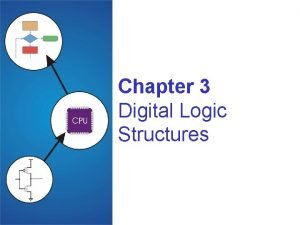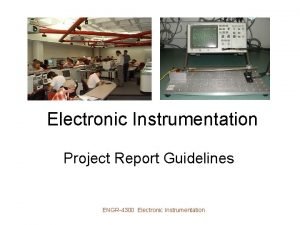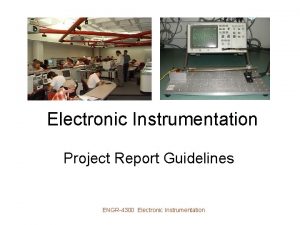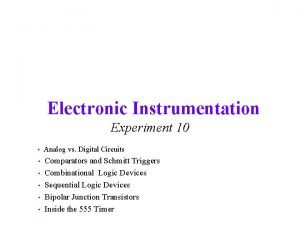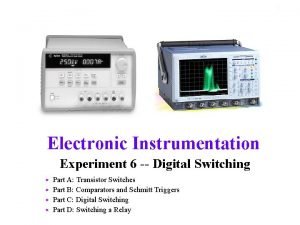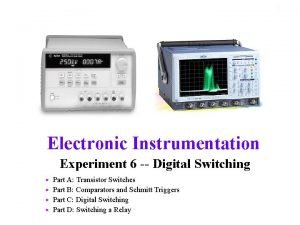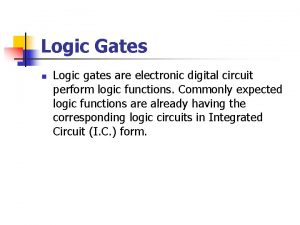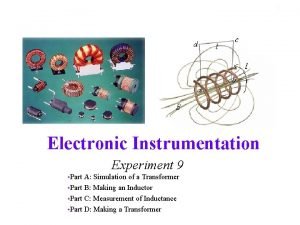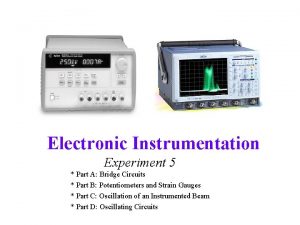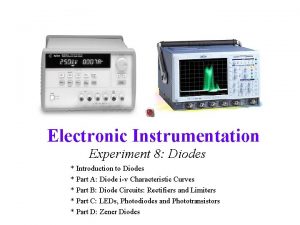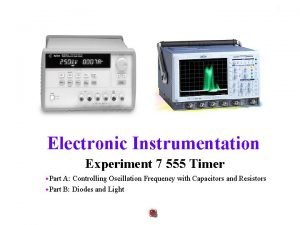1 Electronic Instrumentation Experiment 7 Digital Logic Devices

















































- Slides: 49

1 Electronic Instrumentation Experiment 7 Digital Logic Devices and the 555 Timer Part A: Part B: Part C: Part D: Basic Logic Gates Flip Flops Counters 555 Timers

Part A Basic Logic Gates Combinational Logic Devices w Boolean Algebra w De. Morgan’s Laws w Timing Diagrams w 20 March 2007 Electronic Instrumentation 2

Combinational Logic Devices Logic Gates perform basic logic operations, such as AND, OR and NOT, on binary signals. w We can model the behavior of these chips by enumerating the output they produce for all possible inputs. w In order to show this behavior, we use truth tables, which show the output for all input combinations. w The outputs of combinational logic gates depend only on the instantaneous values of the inputs. w 20 March 2007 Electronic Instrumentation 3

Logic Gates 20 March 2007 Electronic Instrumentation 4

Logic Gate Example: XOR Input A 0 0 1 1 Input B 0 1 20 March 2007 Output X 0 1 1 0 Question: What common household switch configuration corresponds to an XOR? Electronic Instrumentation 5

Boolean Algebra • The variables in a boolean, or logic, expression can take only one of two values, 0 (false) and 1 (true). • We can also use logical mathematical expressions to analyze binary operations, as well. 20 March 2007 Electronic Instrumentation 6

• The basis of boolean algebra lies in the operations of logical addition, or the OR operation, and logical multiplication, or the AND operation. • OR Gate • If either X or Y is true (1), then Z is true (1) • AND Gate • If both X and Y are true (1), then Z is true (1) • Logic gates can have an arbitrary number of inputs. • Note the similarities to the behavior of the mathematical operators plus and times. 20 March 2007 Electronic Instrumentation 7

Laws of Boolean Algebra 20 March 2007 Electronic Instrumentation 8

De. Morgan’s Laws 20 March 2007 Electronic Instrumentation 9

Timing Diagrams – sequential logic • When we deal with binary signals, we are not worried about exact voltages. • We are only concerned with two things: • Is the signal high or low? • When does the signal switch states? • Relative timing between the state changes of different binary signals is much easier to see using a diagram like this. 20 March 2007 Electronic Instrumentation 10

Part B – Flip Flops Sequential Logic Devices w Flip Flops w By-Pass Capacitors w 20 March 2007 Electronic Instrumentation 11

Sequential Logic Devices In a sequential logic device, the timing or sequencing of the input signals is important. Devices in this class include flip-flops and counters. w Positive edge-triggered devices respond to a low-tohigh (0 to 1) transition, and negative edge-triggered devices respond to a high-to-low (1 to 0) transition. w 20 March 2007 Electronic Instrumentation 12

Flip-Flops • A flip-flop is a sequential device that can store and switch betw • It is called a bistable device since it has two and only two possi • It has the capability of remaining in a particular state (i. e. , stori 20 March 2007 Electronic Instrumentation 13

Simple Flip Flop Example: The RS Flip-Flop Q=0 Q=1 20 March 2007 Note that the output depends on three things: the two inputs and the previous state of the output. Electronic Instrumentation 14

Inside the R-S Flip Flop Note that the enable signal is the clock, which regularly pulses. This flip flop changes on the rising edge of the clock. It looks at the two inputs when the clock goes up and sets the outputs according to the truth table for the device. 20 March 2007 Electronic Instrumentation 15

Inside the J-K Flip Flop Note this flip flop, although structurally more complicated, behaves almost identically to the R-S flip flop, where J(ump) is like S(et) and K(ill) is like R(eset). The major difference is that the J-K flip flop allows both inputs to be high. In this case, the output switches state or “toggles”. 20 March 2007 Electronic Instrumentation 16

By-Pass Capacitors V+ GND In a sequential logic device, a noisy signal can generate erroneous results. w By-pass capacitors are placed between 5 V and 0 V to filter out high frequency noise. w A by-pass capacitor should be used in any circuit involving a sequential logic device to avoid accidental triggering. w 20 March 2007 Electronic Instrumentation 17

Part C: Counters Binary Numbers w Binary Counters w 20 March 2007 Electronic Instrumentation 18

Binary – Decimal -- Hexadecimal Conversion 101101011100010110011110110 11 B 5 5 12 5 C 9 5 12 9 B 5 C 59 CF 6 15 C F 6 binary number equivalent base 10 value for each group of 4 consecutive binary digits (bits) 6 corresponding hexadecimal (base 16) digit equivalent hexadecimal number Decimal 8 = 1 x 23 + 0 x 22 + 0 x 21 +0 x 20 = 01000 in Binary Calculator Applet 20 March 2007 Electronic Instrumentation 19

Binary Counters w w Binary Counters do exactly what it sounds like they should. They c Binary numbers are comprised of only 0’s and 1’s. Decimal QD QC QB QA 0 1 2 3 4 5 0 0 1 1 0 0 0 1 0 1 0 0 0 20 March 2007 Electronic Instrumentation 20

Binary Counters are made with Flip Flops DCBA = 1100 DCBA = 1111 Each flip flop corresponds to one bit in the counter. Hence, this is a four-bit counter. 20 March 2007 Electronic Instrumentation 21

Typical Output for Binary Counter 1100 =12 DCBA = 1100 w DCBA = 1111 Note how the Q outputs form 4 bit numbers 20 March 2007 Electronic Instrumentation 22

Part D: 555 -Timers w w w The 555 Timer Inside the 555 -Timer Types of 555 -Timer Circuits Understanding the Astable Mode Circuit Modulation Pulse Width Modulation 20 March 2007 Electronic Instrumentation 23

The 555 Timer w w w The 555 Timer is one of the most popular and versatile integrated circuits ever produced! It is 30 years old and still being used! It is a combination of digital and analog circuits. It is known as the “time machine” as it performs a wide variety of timing tasks. Applications for the 555 Timer include: • Bounce-free switches and Cascaded timers • Frequency dividers • Voltage-controlled oscillators • Pulse generators and LED flashers 20 March 2007 Electronic Instrumentation 24

555 Timer Each pin has a function w Note some familiar components inside w 20 March 2007 Electronic Instrumentation 25

Inside the 555 Timer 20 March 2007 Electronic Instrumentation 26

Inside the 555 Timer • The voltage divider (blue) has three equal 5 K resistors. It divides the input voltage (Vcc) into three equal parts. • The two comparators (red) are op-amps that compare the voltages at their inputs and saturate depending upon which is greater. • The Threshold Comparator saturates when the voltage at the Threshold pin (pin 6) is greater than (2/3)Vcc. • The Trigger Comparator saturates when the voltage at the Trigger pin (pin 2) is less than (1/3)Vcc 20 March 2007 Electronic Instrumentation 27

• The flip-flop (green) is a bi-stable device. It generates two values, a “high” value equal to Vcc and a “low” value equal to 0 V. • When the Threshold comparator saturates, the flip flop is Reset (R) and it outputs a low signal at pin 3. • When the Trigger comparator saturates, the flip flop is Set (S) and it outputs a high signal at pin 3. • The transistor (purple) is being used as a switch, it connects pin 7 (discharge) to ground when it is closed. • When Q is low, Qbar is high. This closes the transistor switch and attaches pin 7 to ground. • When Q is high, Qbar is low. This open the switch and pin 7 is no longer grounded 20 March 2007 Electronic Instrumentation 28

Types of 555 -Timer Circuits w Astable Multivibrator puts out a continuous sequence of pulses 20 March 2007 w Monostable Multivibrator (or one-shot) puts out one pulse each time the switch is connected Electronic Instrumentation 29

w Monostable Multivibrator (One Shot) 20 March 2007 Electronic Instrumentation 30

Behavior of the Monostable Multivibrator The monostable multivibrator is constructed by adding an external capacitor and resistor to a 555 timer. w The circuit generates a single pulse of desired duration when it receives a trigger signal, hence it is also called a one-shot. w The time constant of the resistor-capacitor combination determines the length of the pulse. w 20 March 2007 Electronic Instrumentation 31

Uses of the Monostable Multivibrator • Used to generate a clean pulse of the correct height and duration for a digital system • Used to turn circuits or external components on or off for a specific length of time. • Used to generate delays. • Can be cascaded to create a variety of sequential timing pulses. These pulses can allow you to time and sequence a number of related operations. 20 March 2007 Electronic Instrumentation 32

w Astable Pulse-Train Generator (Multivibrator) 20 March 2007 Electronic Instrumentation 33

Behavior of the Astable Multivibrator The astable multivibrator is simply an oscillator. The astable multivibrator generates a continuous stream of rectangular off-on pulses that switch between two voltage levels. w The frequency of the pulses and their duty cycle are dependent upon the RC network values. w The capacitor C charges through the series resistors R 1 and R 2 with a time constant (R 1 + R 2)C. w The capacitor discharges through R 2 with a time constant of R 2 C w 20 March 2007 Electronic Instrumentation 34

Uses of the Astable Multivibrator • • Flashing LED’s Pulse Width Modulation Pulse Position Modulation Periodic Timers 20 March 2007 Electronic Instrumentation 35

Flashing LED’s w 40 LED bicycle light with 20 LEDs flashing alternately at 4. 7 Hz 20 March 2007 Electronic Instrumentation 36

Understanding the Astable Mode Circuit w 555 -Timers, like op-amps can be configured in different ways to create different circuits. We will now look into how this one creates a train of equal pulses, as shown at the output. 20 March 2007 Electronic Instrumentation 37

First we must examine how capacitors charge w Capacitor C 1 is charged up by current flowing through R 1 w As the capacitor charges up, its voltage increases and the current charging it decreases, resulting in the charging rate shown 20 March 2007 Electronic Instrumentation 38

Capacitor Charging Equations w Capacitor Current w Capacitor Voltage w Where the time constant 20 March 2007 Electronic Instrumentation 39

Understanding the equations w Note that the voltage rises to a little above 6 V in 1 ms. 20 March 2007 Electronic Instrumentation 40

Capacitor Charging and Discharging w There is a good description of capacitor charging and its use in 555 timer circuits at http: //www. uoguelph. ca/~antoon/gadgets/555. html 20 March 2007 Electronic Instrumentation 41

555 Timer w At the beginning of the cycle, C 1 is charged through resistors R 1 and w The voltage reaches (2/3)Vcc in a time 20 March 2007 Electronic Instrumentation 42

555 Timer When the voltage on the capacitor reaches (2/3)Vcc, a switc w The capacitor is discharged to (1/3)Vcc through R 2 to groun w 20 March 2007 Electronic Instrumentation 43

555 Timer w The frequency is then given by 20 March 2007 Electronic Instrumentation 44

555 Animation Output is high for 0. 693(Ra+Rb)C Output voltage high turns off upper LED and turns on lower LED Capacitor is charging through Ra and Rb w http: //www. williamson-labs. com/pu-aa-555 timer_slow. htm 20 March 2007 Electronic Instrumentation 45

555 Animation Output is low for 0. 693(Rb)C Output is low so the upper LED is on and the lower LED is off Capacitor is discharging through Rb 20 March 2007 Electronic Instrumentation 46

PWM: Pulse Width Modulation w Signal is compared to a sawtooth wave producing a pulse width proportional to amplitude 20 March 2007 Electronic Instrumentation 47

What Can Be Done With PWM? Low Duty Cycle Medium Duty Cycle High Duty Cycle w Question: What happens if voltages like the ones above are connected to a light bulb? Answer: The longer the duty cycle, the longer the light bulb is on and the brighter the light. 48 20 March 2007 Electronic Instrumentation

What Can Be Done With PWM? Average power can be controlled w Average flows can also be controlled by fully opening and closing a valve with some duty cycle w 20 March 2007 Electronic Instrumentation 49
 Instrumentation amplifier experiment
Instrumentation amplifier experiment Electronic instrumentation rpi
Electronic instrumentation rpi Rpi electronic instrumentation
Rpi electronic instrumentation Beakman motor
Beakman motor Is the electronic exchange of money or scrip
Is the electronic exchange of money or scrip Electronic field production examples
Electronic field production examples First order logic vs propositional logic
First order logic vs propositional logic First order logic vs propositional logic
First order logic vs propositional logic Third order logic
Third order logic Concurrent vs sequential
Concurrent vs sequential Tw
Tw Software development wbs
Software development wbs Is it x y or y x
Is it x y or y x Combinational logic sequential logic 차이
Combinational logic sequential logic 차이 If x = 0 and y = 1, which output line is enabled?
If x = 0 and y = 1, which output line is enabled? Mechatronic devices examples
Mechatronic devices examples Electronic devices floyd 10th edition
Electronic devices floyd 10th edition Bjt frequency response
Bjt frequency response Solid state electronic devices 7th solution chapter 4
Solid state electronic devices 7th solution chapter 4 Majority and minority carriers
Majority and minority carriers Electronic devices and circuit theory
Electronic devices and circuit theory Electronic devices and circuit theory
Electronic devices and circuit theory Solid state electronic devices ppt
Solid state electronic devices ppt 071-com-0804
071-com-0804 Electronic logging devices comparison
Electronic logging devices comparison Load line analysis of transistor
Load line analysis of transistor Electronic devices and circuit theory
Electronic devices and circuit theory Boylestad
Boylestad In a voltage shunt feedback circuit,
In a voltage shunt feedback circuit, Electronic onboard recorders
Electronic onboard recorders A digital camera is an electronic device
A digital camera is an electronic device Eps full form in commerce
Eps full form in commerce Spld in digital electronics
Spld in digital electronics Fixed and and fixed or is part of which pld
Fixed and and fixed or is part of which pld Program logic device
Program logic device Fixed logic devices examples
Fixed logic devices examples Logic functions
Logic functions Multivabrators are logic devices cover
Multivabrators are logic devices cover Electronique instrumentation
Electronique instrumentation Digital logic design tutorial
Digital logic design tutorial State diagram
State diagram Timing diagram boolean
Timing diagram boolean Digital system design
Digital system design Plc mixer process control problem
Plc mixer process control problem Canonical form digital logic
Canonical form digital logic Digital logic design practice problems
Digital logic design practice problems Digital logic
Digital logic Digital logic design lectures
Digital logic design lectures Digital logic structures
Digital logic structures Consensus theorem
Consensus theorem
